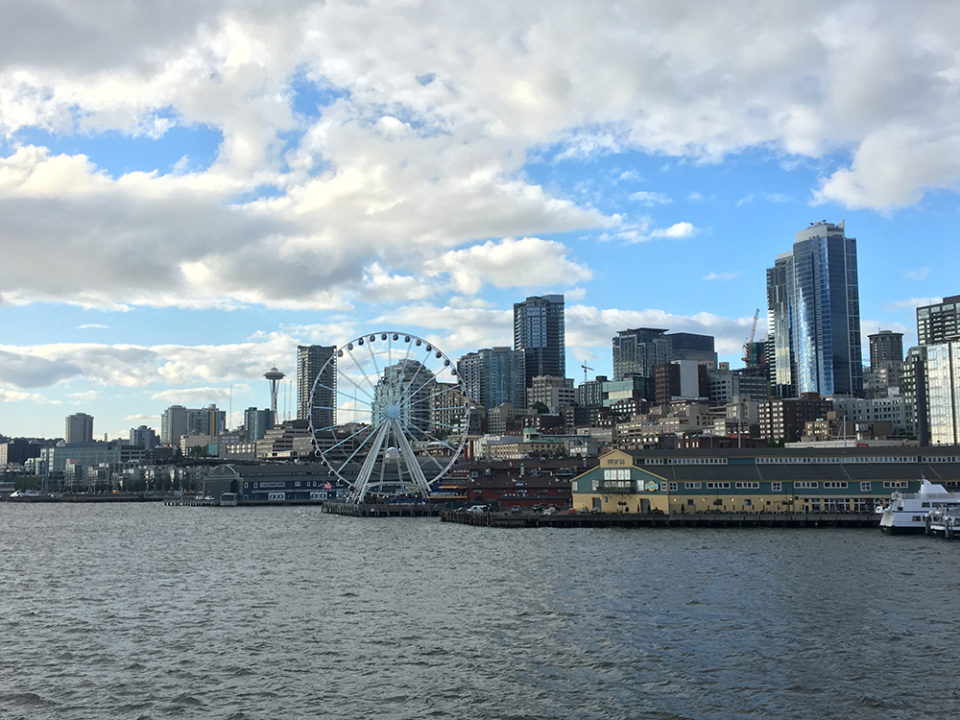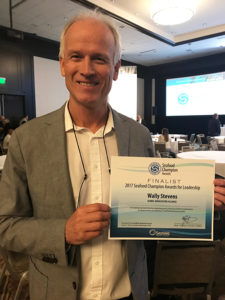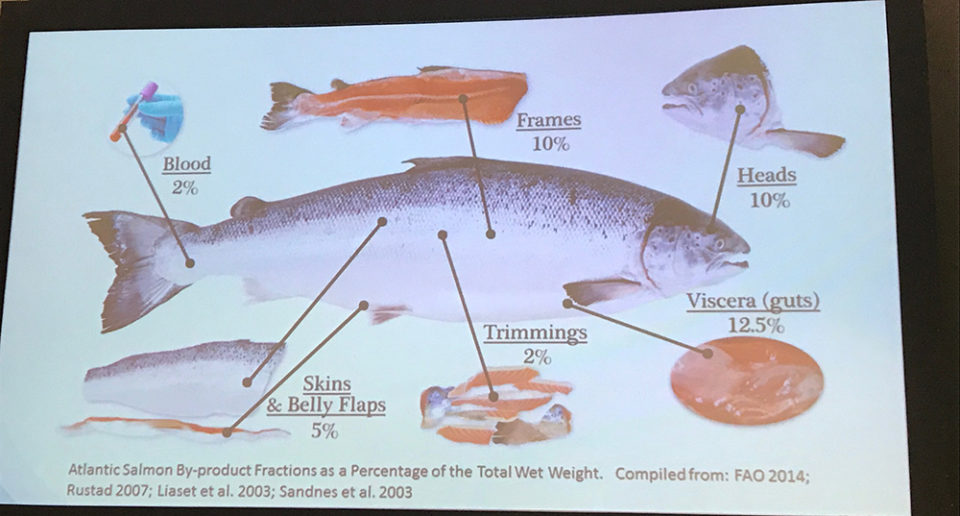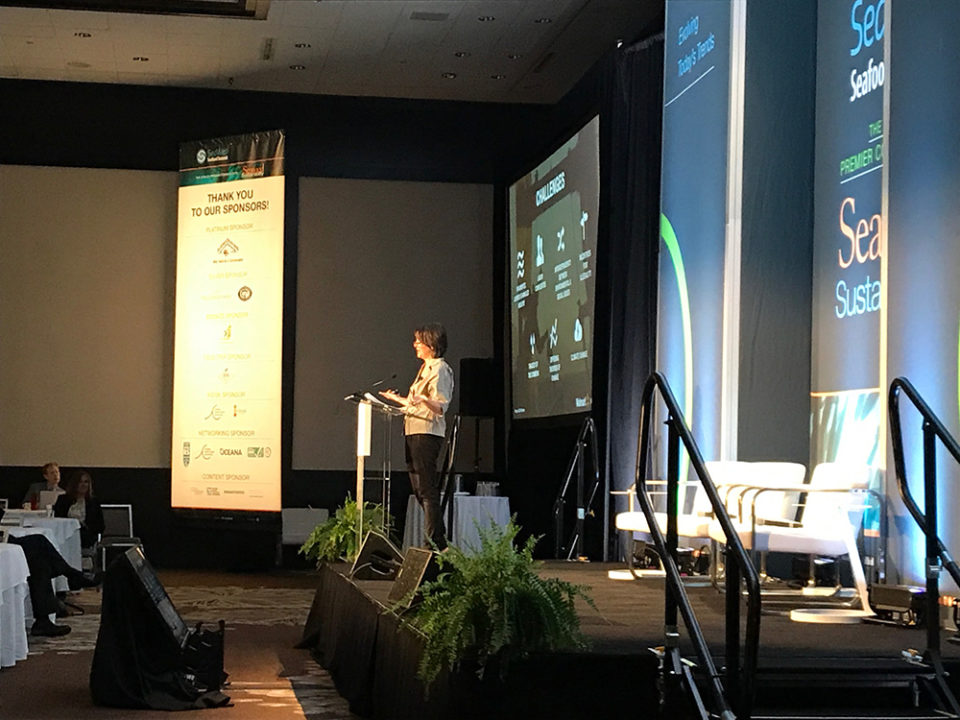Sustainability conference in Seattle convenes industry, NGOs and ocean advocates

The SeaWeb Seafood Summit, held June 5-7 in Seattle, Wash., convenes seafood industry executives, non-governmental organizations (NGOs) and ocean advocates from all over the world. Global Aquaculture Advocate Editor James Wright is reporting from the event. Check back for updates.
FAO offers a statistical snapshot of aquaculture today
On the final day of the SeaWeb Seafood Summit, the United Nations’ Food and Agriculture Organization (FAO) offered attendees a snapshot of aquaculture, from a global perspective.
Professor Manuel Barange, director of the Fisheries and Aquaculture Policy and Resources Division, said aquaculture helps perpetuate the notion that “fish is rich food for poor people,” in that it provides nutrition and economic opportunities.
“Fish represents a larger percentage [of proteins] in the human diet,” in poor, developing nations, he said. With better use of catches, a reduction in waste and proper utilization of trimmings, seafood can be the world’s most efficient protein source.
Simon Funge-Smith, senior officer of fishery & aquaculture department, gave a deeper dive into the industry’s global impact. Funge-Smith noted the following:
- Aquaculture is intensifying worldwide, and at least half of all aquaculture production is for fed species, and that percentage is growing;
- Aquaculture is extremely diverse, with a huge range of species (590) being produced worldwide;
- 90 percent of world’s aquaculture production is in Asia, with China accounting for the lion’s share;
- Despite growing interest in offshore aquaculture, the vast majority of aquaculture globally is done in freshwater (79 percent by volume);
- Aquaculture is slowing down in some areas, with competition for space and feed;
- “More aquaculture may not feed more people,” Funge-Smith said, given a strong focus on luxury species and larger fish that command better profit margins;
- And finally, despite calling for the industry to control its water and fishmeal/fish oil “footprint,” Funge-Smith concluded that aquaculture “is not growing fast enough where the need is greatest,” pointing to developing nations and regions such as Africa.
GAA’s Wally Stevens recognized as ‘Seafood Champion’ finalist
Wally Stevens, executive director of the Global Aquaculture Alliance, was one of the four finalists in the Seafood Champion “leadership” category. The award went to Her Excellency Minister of Maritime Affairs and Fisheries of Indonesia, Susi Pudjiastuti.
Because Stevens was not present at the event, Best Aquaculture Practices Standards Coordinator Dan Lee accepted the finalists’ certificate on his behalf.
Other winners included the International Pole and Line Foundation and Ned Bell, executive chef at the Vancouver Aquarium, for advocacy; Monterey Bay Aquarium Executive Chef Matt Beaudoin, for vision; and FISH-i Africa, for innovation.
Certification schemes have limitations
Certification schemes for farmed shrimp have limitations, said Corey Peet, founder of Postelsia and a leader of the Asian Seafood Improvement Collaborative (ASIC).
“Existing certification schemes are limited in how they can drive value,” said Peet, particularly for small-scale producers in Southeast Asia.
Beginning his presentation with a quote from Einstein – “No problem can be solved from the same level of consciousness that created it” – Peet said it was applicable to the shrimp farming industry.
During his panel presentation titled, “Mind the Gap: Exploring Key Elements to Disrupt the Shrimp Aquaculture Supply Chain to Foster Change,” Peet identified a need to build the right tool to tell the story of these small-scale industries, such as the farming-in-mangrove operations in Vietnam, such as the silvofishery behind Selva Shrimp.
Logan Kock, strategic purchasing and responsible sourcing executive at Santa Monica Seafood, said ASIC is making sustainability ratings like the Monterey Bay Aquarium’s Seafood Watch program more accessible to small-scale producers. And he’s a staunch supporter of Selva Shrimp, which Santa Monica Seafood distributes to customers in the United States.
“Selva Shrimp is definitely not cheap, but sales are incredible,” he said, adding there was robust demand for the product and other high-priced seafood items.
Peet said the SEASAIP (the Southeast Asian Shrimp Aquaculture Improvement Protocol) program he oversees can drive better environmental performance on shrimp farms, foster innovation and get producers to meet the criteria for a yellow (good alternative) rating from Seafood Watch, or even the green (best choice) rating.
Small-scale farmers in Southeast Asia face numerous challenges, and certification is often beyond their reach for cost reasons, said Dr. Le Thanh Luu, director of the International Collaborating Centre for Fisheries and Aquaculture Sustainability in Hanoi, Vietnam.
“Inputs are very high,” said Luu. “Size varies and quality varies, which makes it very difficult for processors, and very difficult to assess for certification. Farms are small, they have no bargaining power. They’re always under pressure.”
No more ‘good’ and ‘bad’ companies
Collaboration, even among competitors, has been a common refrain throughout the conference calls of the Westin Seattle, site of the SeaWeb Seafood Summit.
Avrim Lazar, convener of the Global Salmon Initiative (GSI), told the audience during a plenary session on Monday afternoon that great things can happen when competitors set aside competition to do things together. Lazar cited the “fairly radical goal” that its salmon farming member companies chose in Aquaculture Stewardship Council (ASC) certification.
“My obsession is change. Real change on the ground at speed and at scale,” said Lazar. “And the reason is that I can’t see any other way of feeding the earth’s population in the coming years,” referring to aquaculture.
GSI, he said, is an experiment, but one that he sees as transforming the sector to fulfill its potential. This experiment, he added, needed three things: a clear, hard-to achieve goal to drive them forward; transparency to be held accountable; and precompetitive cooperation (information sharing).
“Reputation is a commons. If your neighbor is polluting, you get the pollution and you get the same reputation,” said Lazar. “I see a paradigm shift, away from the old model of good companies and bad companies. I welcome this because the difference is often the good take on the mantle, and the bad stay bad. It doesn’t change much. Whole-sector change has a bigger impact on the environment.”
Jason Clay, senior VP for food and markets at the World Wildlife Fund (WWF), clearly agreed, saying: “We all know more than any one of us knows.”
Saying that it generally takes about 40 years from awareness of an issue to witnessing real impact on the ground, Clay urged greater precompetitive collaboration to speed up solutions.
“Going forward we don’t have the luxury of that amount of time. We have to figure out how to cut the time from discovery to impact on the ground in half, because in the next 40 years we have to produce twice as much food as we do today, and as much as we have in the last 8,000 combined,” he said.
And while Clay said that fishery and aquaculture certification schemes are generally positive influences on the marketplace, they don’t necessarily improve the reputations of those industries. “Ratings and certifications serve the best performers,” he said. “That’s not where the problem is.”
Aquaculture overcoming its ‘early days’ mistakes
Dan Lee, standards coordinator for the Best Aquaculture Practices, said that aquaculture has had a major impact on global fish supplies in the past two decades.
During his appropriately titled panel presentation, “The Effect of Aquaculture on World Fish Supplies – 20 Years On,” on Monday, Lee said that the industry has not only corrected many of the mistakes that were made during its “early days,” fish farmers have largely broken free of the constraints posed by limited global supplies of fishmeal and fish oil.
“It’s all about food production for a growing planet and producing protein in an efficient way,” said Lee.
Shrimp farming, for instance, no longer cuts down mangrove forests in regions like Southeast Asia, using ponds in Honduras as an example of best practices today. Instead of farming in the mangroves, shrimp ponds there are placed on salt flats. And the modernization of hatcheries has also made a big impact.
And despite using fewer marine ingredients in aquafeeds, such as fishmeal and fish oil, the nutritional quality of farmed seafood products is still good, said Lee.
Andrew Jackson of IFFO, the Marine Ingredients Organization, said that carnivorous aquaculture feeds, such as for salmon, started out with about 70 percent marine ingredients, but the ratio today is closer to 30 percent. “By 2025, it’ll be less than 10 percent,” he said.
And feeds are more efficient, he added, as feed conversion ratios (FCRs) have trended downward consistently. In the 1980s, FCRs in the salmon industry were about 1.9 kilos of feed for each kilo of salmon produced. That number dipped to 1.4 kilos in the 1990s and was down to 1.15 kilos in 2016, said Jackson.
Julien Stevens, a researcher with Kampachi Farms, LLC, relayed some interesting research he did with the University of Stirling on salmon byproducts.
“[There’s] real potential to increase sustainability through their use,” he said.
Farmed fish byproducts have four main uses, he added: food and food ingredients for human consumption; specialty products like nutraceuticals, pharmaceuticals, cosmetics, faux leather and burn treatments; ingredients in aquafeeds; and biofuels and fertilizers.
Corey Peet, founder of Postelsia, said feed was not the biggest issue facing aquaculture’s future. Stabilizing production and preventing disease are crucial, he said.
Delivering some “unsolicited advice for the aquaculture industry,” Peet said the industry, is “painted with too broad of a brush” and that its diversity needs to be recognized.
“There’s all kinds of shrimp farming: intensive shrimp farming; semi intensive; mangrove shrimp farming systems, like in Vietnam. But we call it out in the market as just shrimp farming. [We need to] call out the bad ones and promote the good ones if we want aquaculture to be all that it can be.”
Peet also urged aquaculture enthusiasts to “tone down the rhetoric” because it “is a disservice to over-promote aquaculture. It’s fine to be excited but losing objectivity is counterproductive,” he concluded.

Walmart sustainability officer voices disappointment in Trump decision
Kathleen McLaughlin, the chief sustainability officer at Walmart, delivered the opening keynote address at the Summit and identified seafood as one of 20 commodities the company has pledged to make “truly sustainable” by 2025.
Vowing to “make sustainability practices practical, the way we do business,” McLaughlin took exception with U.S. President Donald Trump’s recent decision to withdraw the United States from the Paris Accord, a global agreement designed to combat climate change.
“We’re disappointed with the decision last week,” she said.
Regarding seafood, McLaughlin said the top five issues to address in the seafood space are overfishing; illegal, unregulated and unreported (IUU) fishing; health and safety; forced labor; and food security.
“[Seafood is a] fragmented, layered co-mingled industry with labor complexities and an
interdependency between environmental and social issues,” she added. “We need to be systems thinkers” to discontinue incentives for illegal behavior and to identify the root causes.
Jim Cannon, CEO of the Sustainable Fisheries Partnership, said fishery management challenges facing governments is “one of political will” and that “industry leadership is more influential than NGOs.”
Cannon added that SFP will be measuring fishers’ wages and other socioeconomic indicators. “We do care about the equity in those industries,” he said.

ASC-certified salmon earns yellow rating
Farmed salmon certified to the Aquaculture Stewardship Council (ASC) standard is now recognized as a Seafood Watch good alternative (yellow rating) by the Monterey Bay Aquarium, the certification organization announced on Monday before the SeaWeb Seafood Summit began in Seattle.
Avrim Lazar, convener of the Global Salmon Initiative (GSI), said that 25 percent of the world’s farmed salmon supplies now qualify for the upgraded rating, representing some 350,000 metric tons of product – a total that could be 1 million metric tons by 2020.
“I’m very sensitive to the problems facing businesses with the many standards in the marketplace,” said Lazar. “I’m always worried about harmonization. If we aim for a common denominator, we’re doing anyone any favors. They’re harmonizing up. As a business person, it’s great to see come clarity. As an environmentalist, it’s not a compromise on standards.”
Ryan Bigelow, manager of the Seafood Watch program, said the “optics” of the announcement are important, that it was “good for us to show that we can collaborate and cooperate publicly, and not beat the industry over the head with a stick.”
“Salmon is the most important species out there,” he added. “For us, this is a huge step.”
Author
-

James Wright
Editorial Manager
Global Aquaculture Alliance
Portsmouth, NH, USA

